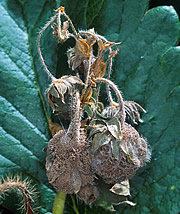This page has been archived and is being provided for reference purposes only. The page is no longer being updated, and therefore, links on the page may be invalid.
Medicinal Compound Gets New Life as Fungicide
By Luis PonsFebruary 23, 2005
Growers of many fruit and ornamental crops have new weapons for fighting destructive fungi, thanks to Agricultural Research Service (ARS) and University of Mississippi (UM) scientists who've transformed a medicinal compound into an agricultural fungicide.
The naturally occurring compound, called sampangine, was first patented by UM in 1990 as a treatment for human fungal infections. It was never released pharmaceutically.
Now, plant pathologist David Wedge of ARS' Natural Products Utilization Research Unit and UM associate professor Dale Nagle have been issued a patent for sampangine and similar, related compounds as broad-spectrum, low-toxicity controls of fungal plant pathogens that threaten agriculture.
The ARS unit and the university are both based in Oxford, Miss. ARS is the U.S. Department of Agriculture's chief scientific research agency.
According to the new patent--US No. 6,844,353--sampangine-based compounds can control such fungi as Botrytis cinerea, which causes gray mold on tomatoes; Colletotrichum fragariae, which produces anthracnose crown rot and wilt in strawberry plants; C. gloeosporioides, which sickens numerous plants, including grapes, strawberry, citrus and papaya; and Fusarium oxysporum, which induces vascular wilt in crops such as potato, sugarcane and many ornamentals.
Plant pathologist Barbara Smith of the ARS Small Fruits Research Station in Poplarville, Miss., helped evaluate the effectiveness of the compounds against strawberry anthracnose.
Sampangine can greatly help the United States' $31-billion-a-year minor crop industry. For example, in recent studies in Louisiana, Wedge and Smith verified that some Botrytis fungal strains now resist fungicides commonly used against these strains.
According to Wedge, sampangine shows potential for managing fungicide resistance against important diseases and augmenting use of fungicides that are vulnerable to resistance. The sampangine-based fungicides may also find use as postharvest and antidecay agents.
This work is also the focus of a cooperative research and development agreement between ARS and Icoria Inc., a North Carolina biotechnology firm. The agreement calls for work toward determining sampangine's modes of action, and identifying additional related compounds with commercial potential for managing agriculturally important plant-pathogenic fungi.



